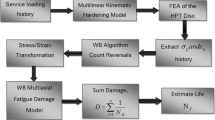Abstract
We created three-dimensional models of turbine disc and blades of a type of aero-engine according to their geometries. Extant studies show that low cycle fatigue is the main failure mechanism of turbine disc. By using a non-linear elastic-plastic finite element method, the static stress and strain state of the critically high stress regions, which can lead to operational failures, are determined. On the basis of stress-strain relation, a modified Walker strain life prediction model is proposed with no required knowledge on the mean stress correction. Then the predicted life data from the modified Walker strain model are compared with the testing results. After the verification, the modified Walker strain life prediction model and Miner’s rule were applied to predict the lifetime of the turbine disc under various operating conditions.
Similar content being viewed by others
References
L. Witek, Numerical simulation of fatigue fracture of the turbine disc, Fatigue of Aircraft Structures, 1 (4) (2012) 114–122.
G. F. Harrison and W. J. Evans, A review of fatigue assessment procedures for aeroengine fracture critical components, J. of the Engineering Integrity Society (2000).
S. A. Meguid, P. S. Kanth and A. Czekanski, Finite element analysis of fir-tree region in turbine discs, Finite Elements in Analysis and Design, 35 (4) (2000) 305–317.
R. A. Cláudio, C. M. Branco and E. C. Gomes, Life prediction of a gas turbine disc using the finite element method, Eighth Portuguese Conference on Fracture (2002).
X. Wu, W. Beres and S. Yandt, Challenges in life prediction of gas turbine critical components, Canadian Aeronautics and Space J., 54 (2) (2008) 31–39.
L. Witek, Failure analysis of turbine disc of an aero engine, Engineering Failure Analysis, 13 (1) (2006) 9–17.
Z. Yang, C. B. Kim and C. Cho, The concentration of stress and strain in finite thickness elastic plate containing a circular hole, International J. of Solids and Structures, 45 (3) (2008) 713–731.
S. J. Kim, S. Y. Han and E. S. Shin, Micromechanics-based evaluation of the poroelastic effect and stress concentration in thermochemically-decomposed composites, JMST, 27 (10) (2013) 3139–3147.
The Editorial Committee of China Aeronautical Materials Handbook, China Aeronautical Materials Handbook, Beijing, China (2002).
H. Ou, B. Lu and Z. S. Cui, A direct shape optimization approach for contact problems with boundary stress concentration, JMST, 27 (9) (2013) 2751–2759.
C. H. Tao, P. D. Zhong and R. Z. Wang, Failure analysis and prevention for rotor in aero-engine, Beijing, China (2008).
C. L. Liu, Reliability analysis for an aero engine turbine disk under low cycle fatigue condition, Acta Metallurgica Sinica, 17 (4) (2009) 514–520 (In English).
G. Harrison, Modes of gas turbine component life consumption in recommended practices for monitoring gas turbine engine life consumption, RTO Technical Report 28 (RTO-TR-28, AC/323/(AVT)TP/22) (2000).
L. P. Gan, H. Z. Huang and S. P. Zhu, Fatigue reliability analysis of turbine disk alloy using saddlepoint approximation, International J. of Turbo & Jet-engines, 30 (3) (2013) 217–229.
K. Walker, The effects of stress ratio during crack propagation and fatigue for 2024-t3 and 7075-t6 aluminum,Effect of Environment and Complex Load History on Fatigue Life, ASTM STP 462, American Society of Testing and Materials (1970) 1–14.
K. N. Smith, P. Watson and T. H. Topper, A stress-strain function for the fatigue of metals, J. of Materials, 5 (4) (1970) 767–768.
M. E. Melis, E. V. Zaretsky and R. August, Probabilistic analysis of aircraft gas turbine disk life and reliability, Journal of Propulsion and Power, 15 (5) (1999) 658–666.
S. P. Zhu, H. Z. Huang and L. P. He, A generalized energybased fatigue–creep damage parameter for life prediction of turbine disk alloys, tEngineering Fracture Mechanics, 90 (2012) 89–100.
W. G. Wang, Research on prediction model for disc lcf life and experiment assessment methodology, Nanjing University of Aeronautics and Astronautics (2006).
S. M. H Kabir and T. Yeo, Fatigue behavior of an austenitic steel of 300-series under non-zero mean loading, JMST, 26 (1) (2012) 63–71.
S. P. Zhu, H. Z. Huang and Z. L. Wang, Fatigue life estimation considering damaging and strengthening of low amplitude loads under different load sequences using fuzzy sets approach, International J. of Damage Mechanics, 20 (6) (2011) 876–899.
C. E. Jaske, C. E. Feddersen and K. B. Davis, Analysis of fatigue, Fatigue Crack Propagation and Fracture Data, NASA CR-132332 (1973) 49–54.
J. H. Park and J. H. Song, Detailed evaluation of methods for estimation of fatigue properties, International J. of Fatigue, 17 (5) (1995) 365–373.
M. A. Miner, Cumulative damage in fatigue, J. of Applied Mechanics, 12 (3) (1945) 159–164.
Author information
Authors and Affiliations
Corresponding author
Additional information
Recommended by Editor Chongdu Cho
Zhiqiang Lv is currently a Ph.D. candidate in Mechanical Engineering at the University of Electronic Science and Technology of China. His research interests concern fatigue life prediction and fatigue reliability.
Hong-Zhong Huang is a Professor of the School of Mechanical, Electronic, and Industrial Engineering, at the University of Electronic Science and Technology of China. He received a Ph.D. in Reliability Engineering from Shanghai Jiaotong University, China and has published in the fields of reliability engineering, optimization design, fuzzy sets theory, and product development.
Huiying Gao is currently a Ph.D. candidate in Mechanical Engineering at the University of Electronic Science and Technology of China. Her research interests include fatigue strength evaluation, fatigue life prediction and fatigue reliability analysis.
Fang-Jun Zuo is a doctoral candidate in University of Electronic Science and Technology of China. Her research interests include fatigue life prediction and design for reliability.
Hai-Kun Wang is currently a Ph.D. candidate in Mechanical Engineering at the University of Electronic Science and Technology of China. He received his M.S. in Vehicle Engineering from the South China University of Technology. His research interests include reliability analysis, maintenance decisions, prognostics and health management.
Rights and permissions
About this article
Cite this article
Lv, Z., Huang, HZ., Gao, H. et al. Lifetime prediction for turbine discs based on a modified Walker strain model. J Mech Sci Technol 29, 4143–4152 (2015). https://doi.org/10.1007/s12206-015-0908-1
Received:
Revised:
Accepted:
Published:
Issue Date:
DOI: https://doi.org/10.1007/s12206-015-0908-1



